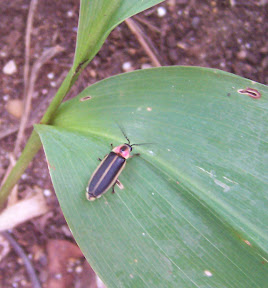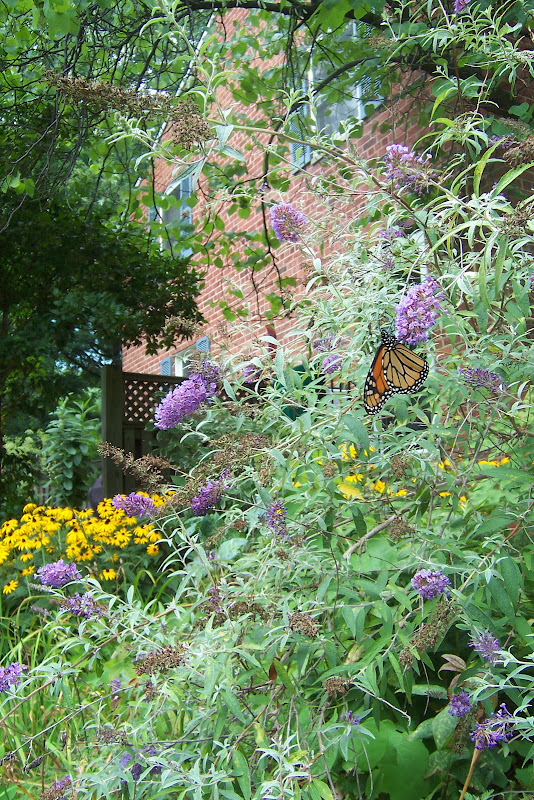Citizen science: collaborative projects for teachers and their class
By Peggy Ashbrook
Posted on 2009-08-07
I was excited to see a Monarch butterfly land on the Butterfly Bush in the yard (I hesitate to call it a garden).
 Does that mean that the Milkweed plant may yet become a home to Monarch caterpillars? I haven’t seen any eggs but there is still time. Maybe another insect has already staked a claim to the Milkweed, making it unattractive to butterflies. Monarch butterfly migration is the subject of a citizen science project called Monarch Watch, which encourages the creation of “Monarch Waystations”, plantings of caterpillar food (milkweeds) and nectar sources for the adult butterflies. This is a project your class could initiate in the spring after studying the butterfly life cycle.
Does that mean that the Milkweed plant may yet become a home to Monarch caterpillars? I haven’t seen any eggs but there is still time. Maybe another insect has already staked a claim to the Milkweed, making it unattractive to butterflies. Monarch butterfly migration is the subject of a citizen science project called Monarch Watch, which encourages the creation of “Monarch Waystations”, plantings of caterpillar food (milkweeds) and nectar sources for the adult butterflies. This is a project your class could initiate in the spring after studying the butterfly life cycle.Read more about butterflies and how they are the same and different from moths in What’s the Difference Between a Butterfly and a Moth? by Robin Koontz with informative illustrations by Brandelin-Dacey (Picture Window Books, 2010). Both are in the group Lepidoptera and your children will love to become Lepidopterists, butterfly and moth scientists. Butterfly information is also available online from California to Florida. See the Educators’ Guide: Butterfly Rainforest at the Florida Museum of Natural History for answers to questions such as “How do Lepidoptera see, taste and hear?”
Citizen science projects are one way to connect your class with habitats other than your local one, and to broaden their knowledge of the world while helping them understand that sometimes science is a collection of data collected over time by many individuals. Here are some activity ideas that may inspire you to participate with your class, and join with others in a network to provide data that can be used by other classes and scientists.
In the Square of Life project, students plot square meters in their school yards and record all the living and non-living things they find in the square. They compare the information with what other classes have found by looking at the information posted on the website. View student reports to see how your class can learn by participating in the project which was developed by Center for Innovation in Engineering and Science Education (CIESE) and Bank Street College of Education .
In Bucket Buddies, another CIESE project, students collect samples from ponds to answer the question: Are the organisms found in pond water the same all over the world? Then they compare their data with that from other classes and look for patterns.
 Participating in Firefly Watch means observing and recording the presence or absence of fireflies in your area. Read about “How These Beetles Create Light” and what scientists know in David Farenthold’s article in the Washington Post.
Participating in Firefly Watch means observing and recording the presence or absence of fireflies in your area. Read about “How These Beetles Create Light” and what scientists know in David Farenthold’s article in the Washington Post.On one recent morning with the unseasonable summer temperature of 64°F, I saw a bumble bee resting on a purple cone flower, perhaps waiting for the sun to warm it up. I was tempted to pet it! If you are in Illinois and your students are interested in taking photos of bees, learn about Beespotters, another project where citizen scientists lend a hand. One beespotter’s photo showed a rusty-patched bumble bee, Bombus affinis, a bee that was thought to be locally extinct!
Learning about the lives of insects can expand our students’ world.
Peggy
Disclaimer: The views expressed in this blog post are those of the author(s) and do not necessarily reflect the official position of the National Science Teaching Association (NSTA).



